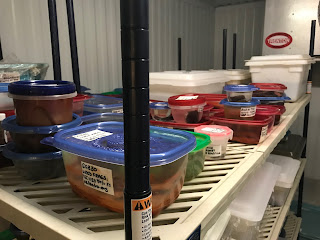 |
| Ruggles' Battery replica guns at Shiloh (NPS) |
[Updated April 4 to indicate one cannon crew has canceled]
Visitors to Shiloh National Military Park next weekend will experience the largest artillery firing demonstration on Duncan Field, where in 1862 more than 50 Confederate guns pounded Union troops in the epic fight at the Hornet’s Nest.
Supervisory park ranger Joe Davis told the Picket that 10 cannon will
be fired at a living history event on Saturday, April 7, during a four-day commemoration
of the 156th battle anniversary.
 |
| Brig. Gen. Ruggles |
The line of 53 Confederate guns (some historians put the number at 62)
was the largest concentration of artillery up to that point in the Civil War.
"You want to give the sound of a battle as close as we
can,” said park ranger Chris Mekow, indicating visitors to the federal park in
Tennessee should get a taste of “the chaos involved in a live
battlefield."
 |
| Fierce fighting at Shiloh (Library of Congress) |
The artillery crews will be joined by about 80 infantry and
15 cavalry re-enactors. The group will provide tactical field maneuvers and
firing demonstrations throughout the day, Davis said.
Artillery crews from National Park Service Civil War sites
at Kennesaw Mountain (Ga.), Stones River (Tenn.), and Chickamauga (Ga.) will be
among those taking part.
One might have expected the largest artillery demonstration
to have occurred during the 150th anniversary in 2012, but the park
did not do such a program because there was a re-enactment on a private site. Mekow
said there will be no depiction of casualties. Rather, visitors will get an
idea of Rebel tactics and strategy.
Confederate Brig. Gen. Daniel Ruggles assembled the batteries on the western part of Duncan Field to fire on the Union center on the Sunken Road after
it became apparent some extra punch was needed to dislodge their foes. The cotton
field belonged to the J.R. Duncan family.
 |
| Capt. Hickenlooper |
Eventually, the massive Confederate firepower – which included batteries from Arkansas, Tennessee, New Orleans and Mississippi -- wore down the Federal flanks and infantry took the Hornet’s Nest and many prisoners after about eight
separate attacks. (Confederates named the area for what they described as enemy
bullets sounding like angry hornets).
In his To the Sound of the Guns blog, Craig Swan said Ruggles’ Battery
played a major part in taking the Hornet’s Nest, but not solely because of its
firepower.
“I think more than anything what caused the collapse of the Hornet’s Nest
was the Confederate flanking and encirclement. That in consideration,
perhaps the most important contribution of Ruggles’ guns was to hold the
Federal’s attention,” Swain writes. “So perhaps in retrospect the impact of
Ruggles’ batteries was more in word than deed.”
(Interestingly, the National Park Service says more recent research tends to show that the Hornet’s Nest, while seeing fierce fighting, may not have been
as important as lesser-known areas of the battlefield.)
By nightfall of April 6, things looked pretty bleak for the
boys in blue across the entire battlefield. But the stubborn Federal resistance at the Hornet's Next and elsewhere bought time to organize a counterattack the next day.
Brig. Gen. William T. Sherman visited the camp of commanding Maj. Gen.
Ulysses Grant.
Catton wrote:
“He came on Grant, at last, at midnight or later, standing under the tree in
the heavy rain, hat slouched down over his face, coat-collar up around his
ears, a dimly-glowing lantern in his hand, cigar clenched between his teeth.
Sherman looked at him; then, "moved," as he put it later, "by
some wise and sudden instinct" not to talk about retreat, he said:
"Well, Grant, we've had the devil's own day, haven't we?"
Grant said
"Yes," and his cigar glowed in the darkness as he gave a quick, hard
puff at it, "Yes. Lick 'em tomorrow, though."
Aided by reinforcements, the Union army regrouped on April 7 and turned
near-certain defeat into victory, retaking ground lost the day before.
 |
| Gun at Duncan Field in 2012 (Picket photo) |
Current schedule for the April 7 living history (check the park website here for other events during the anniversary):
10 a.m.: Artillery firing demonstration
11 a.m.: Infantry tactical and firing demonstration
12 p.m.: Cavalry tactical
and firing demonstration
12:30 p.m.: Civil War music
1 p.m.: Artillery firing demonstration
2 p.m.: Program on Dr. Mary Safford (Civil War nurse; that
presentation will be at the visitor center)
3 p.m.: Combined arms tactical and firing demonstration. (The infantry, cavalry, and artillery will be in the
demonstration field at the same time.)
Each program will last 30 minutes. There will be
narration to describe to the public information throughout each of the
scheduled programs, said Davis.
“There will be period camps set up for the public to view
and they can visit with the living historians to view the life of a soldier in
a camp setting and they can interact with the re-enactors with questions they
may have.”





























